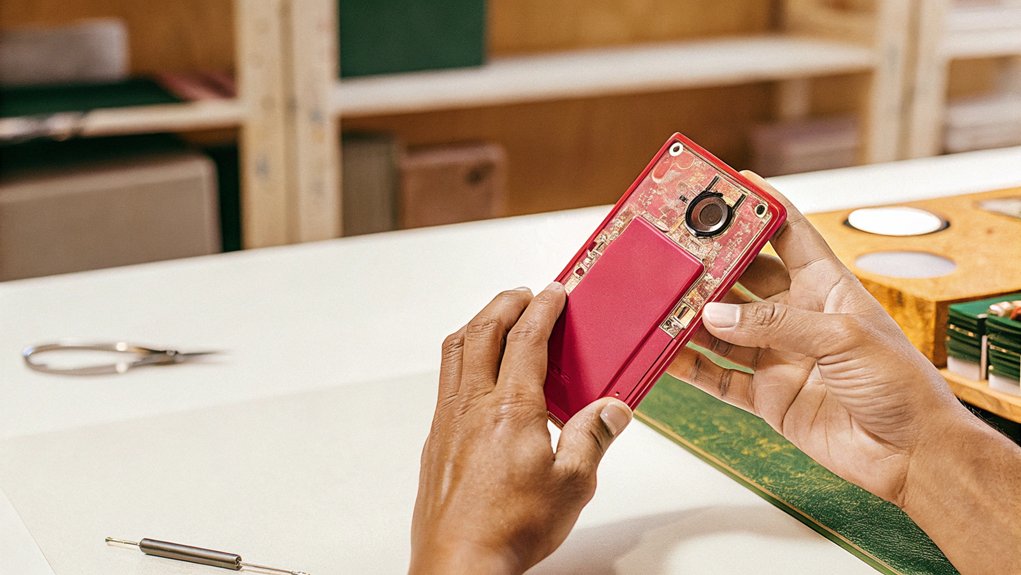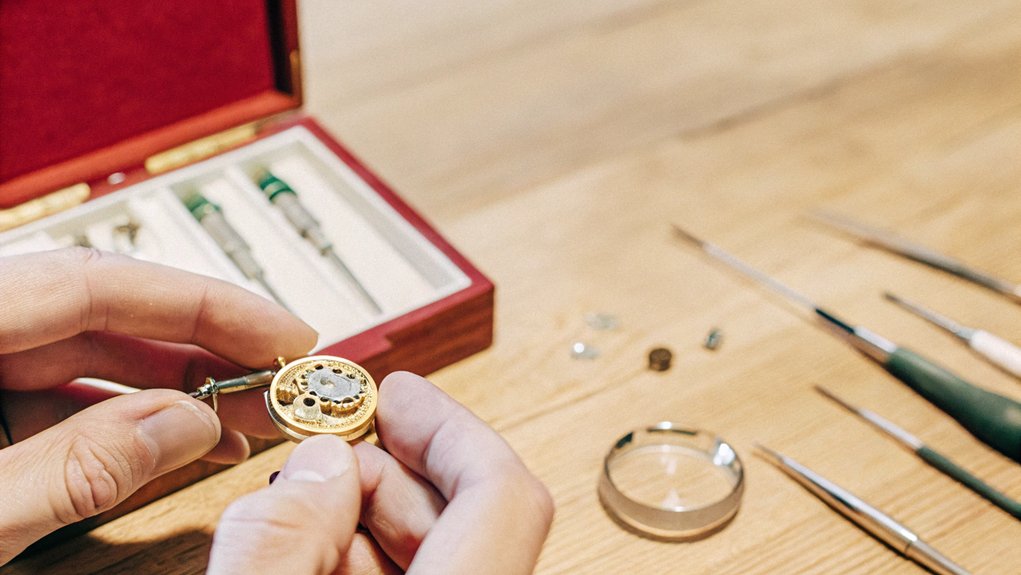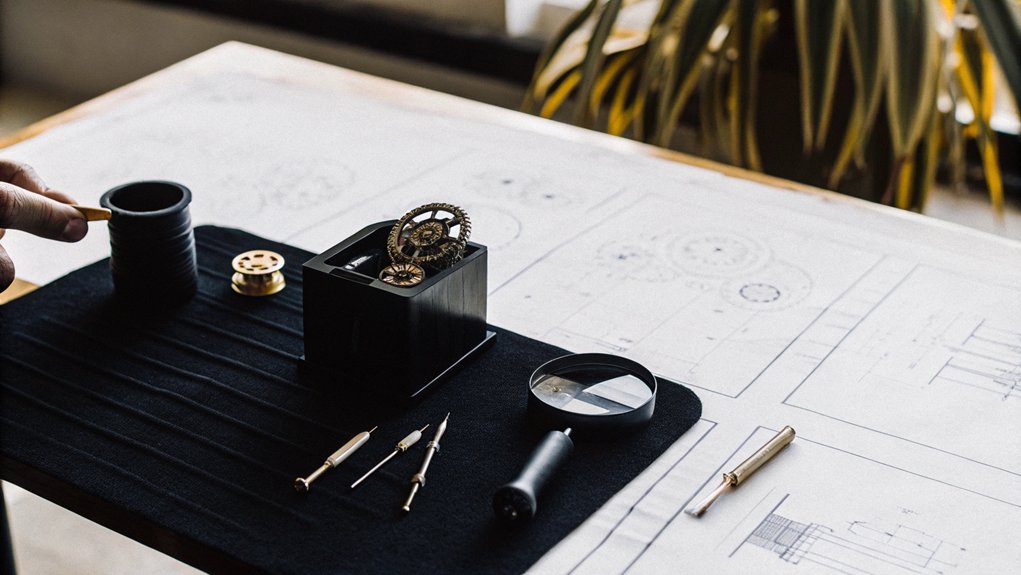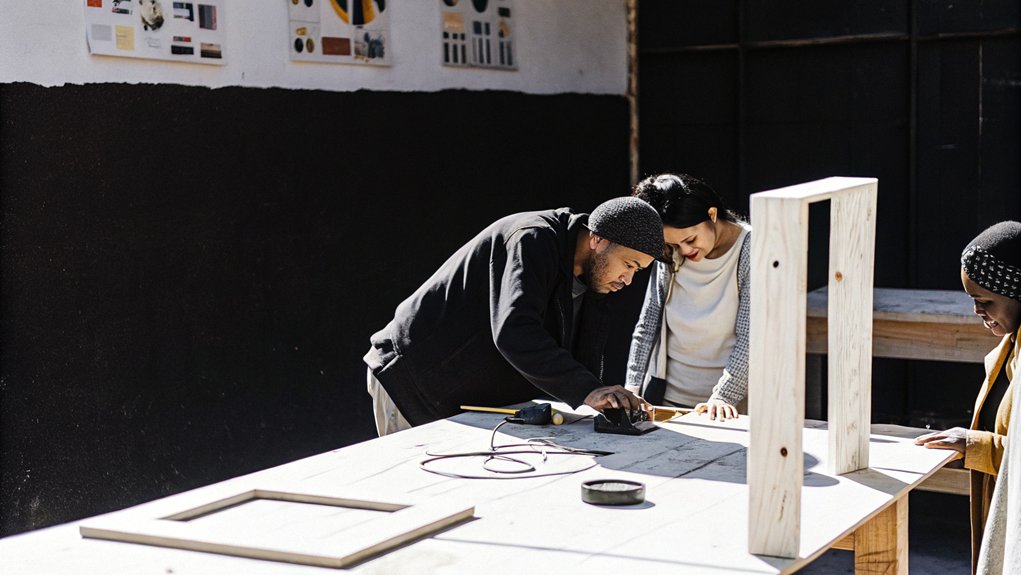You might not realize that repairing items can cut
embodied emissions by 57-87%. This statistic highlights the significant impact of
refurbishment on sustainability. By extending product lifecycles, we not only reduce waste but also conserve resources, using just 15% of the energy needed for new production through remanufacturing. As we explore the barriers to repair and design considerations for longevity, you’ll see how fostering a
culture of repair can drive economic growth and community engagement.
Key Takeaways
- Repair and refurbishment significantly extend product lifespans, reducing embodied emissions by 57-87% compared to creating new items.
- Remanufacturing requires only 15% of the energy needed for new production, promoting sustainability.
- Access to spare parts and repair manuals is essential for enhancing product reparability and consumer engagement.
- Engaging communities through workshops and collaborative recycling initiatives fosters awareness and participation in circular economy practices.
- The Right to Repair advocacy addresses barriers, making repairs more cost-effective and accessible for consumers.
The Importance of Repair and Refurbishment in Sustainability
While many consumers may overlook the benefits of
repair and refurbishment, these practices play a critical role in promoting
sustainability. By extending the lifespan of products, you can greatly reduce
embodied emissions—by 57-87% compared to new production. This not only minimizes your environmental impact but also fosters a sense of community responsibility.
For instance, remanufacturing requires just 15% of the energy needed for new items, showcasing
energy efficiency. Additionally, 96% of damaged foldable reusable plastic crates can be repaired, revealing the practicality of repair strategies.
Companies like Envirotech have diverted over 11 million kg of furniture from landfills through refurbishment. With new
EU regulations mandating spare parts availability, embracing repairability strengthens our collective commitment to
sustainable living.
Understanding Product Life Extension and Its Benefits
Understanding
product life extension is essential for anyone looking to make informed decisions about sustainability. By focusing on
repair, refurbishment, and remanufacturing, you can greatly enhance a product’s life while minimizing
environmental impacts.
Extending product life reduces the need for new production, which lowers
embodied emissions from resource extraction and manufacturing. Remarkably, remanufacturing uses 80-98% fewer raw materials and requires only 15% of the energy needed for new production.
This process can reduce emissions by 57-87% and keep 70-90% of waste out of landfills. By embracing product life extension, you not only contribute to a
sustainable future but also support economic growth and job creation within
circular economies, fostering a community that values sustainability and shared prosperity.
The Role of Circular Economy in Product Lifecycles
In the context of the
circular economy, closing material loops is essential for extending
product lifecycles through effective reuse and remanufacturing strategies.
By designing for durability and enhancing repair infrastructure, you can greatly reduce waste and resource consumption while promoting
sustainability.
This approach not only conserves valuable materials but also drives economic growth by creating demand for longer-lasting products.
Closing Material Loops
Closing material loops is vital for fostering a sustainable future, where products are designed with their entire lifecycle in mind.
By implementing
circular economy principles, you can extend the useful life cycle of products through strategies like
reuse, repair, and remanufacturing. These methods not only
minimize waste but also greatly reduce resource extraction, with remanufacturing requiring 80-98% fewer raw materials than traditional methods.
Extending product lifespans can cut
embodied emissions by 57-87%, which is vital given that an average office task chair’s carbon footprint is 72 kg CO2e.
By adopting
strategic procurement practices that prioritize circular principles, you enhance resource efficiency, support economic growth, and cultivate partnerships with suppliers committed to sustainability.
Together, we can close material loops for a greener future.
Designing for Durability
Durability in product design is essential for fostering a sustainable circular economy, where longevity and reparability are prioritized. By focusing on creating products that withstand wear and tear, you can greatly reduce material consumption and environmental impact. The European Commission’s Ecodesign Directive encourages manufacturers to provide spare parts and repair information, enhancing repairability. Consider the energy savings from remanufacturing, which only requires 15% of that needed for new products, while reducing emissions by 57-87%. This table illustrates the impact of durable design on repairability:
| Aspect | Impact |
| Energy Consumption | 15% of new products |
| Emission Reduction | 57-87% less |
| Repair Cost vs. Replace | 30-40% cheaper |
| Repair Success Rate | 96% for reusable crates |
| Resource Savings | Minimized extraction & waste |
Enhancing Repair Infrastructure
Repair infrastructure greatly influences the reparability of products, directly impacting the overall effectiveness of a
circular economy. When you enhance
repair infrastructure, you tackle significant barriers like access to
spare parts and
repair manuals.
The European Commission’s regulations mandate manufacturers to guarantee spare parts are available within 15 days, creating a more supportive repair environment.
Consider the foldable reusable plastic crates (RPCs); 96% are repaired annually, showcasing the power of effective design and repairability. Yet, convenience and technical barriers still hinder consumer participation.
By strengthening repair infrastructure, you not only reduce
electronic waste but also contribute to
sustainability efforts, extending product lifecycles and minimizing the need for new production.
Embracing this approach fosters a sense of community and shared responsibility.
Consumer Barriers to Repair and How to Overcome Them
While many consumers recognize the
environmental and economic benefits of repairing products, several barriers often deter them from taking action.
Convenience plays a significant role;
high repair service costs and limited access to repair infrastructure make repairs seem intimidating.
With about 26 identified barriers, including the
lack of spare parts and repair manuals, consumers find it challenging to undertake repairs themselves.
You’re more likely to engage in repairs when costs are 30-40% lower than new items, emphasizing
cost-effectiveness.
Advocating for the
Right to Repair can dismantle these obstacles.
Policies that promote access to spare parts and repair information can foster greater consumer engagement, encouraging you to embrace repairs and extend product lifecycles.
Repairable Products: Design Considerations for Longevity
When designing products for
longevity, it’s essential to incorporate features that facilitate
easy disassembly and part replacement.
Repairable products not only extend their lifecycle but also align with
sustainability goals, as emphasized by the European Commission. By making repairs easier, you reduce material consumption and waste, allowing products to be restored efficiently.
Take repairable plastic crates, for example; with only 1% damaged annually and 96% of those repaired, their design showcases the effectiveness of longevity-focused engineering.
New EU regulations further support this by mandating access to
spare parts and repair information.
Case Studies: Successful Examples of Repair and Refurbishment
Numerous organizations are leading the way in demonstrating
effective repair and refurbishment strategies that not only benefit their bottom lines but also contribute greatly to
sustainability efforts.
For instance, Envirotech’s
remanufacturing of over 40,000 workstations and 100,000 chairs diverted more than 11 million kg of furniture from landfills, greatly reducing
carbon emissions. By requiring only 15% of the energy needed to produce new products, they’ve achieved emissions reductions of 57-87%.
Additionally, repairable plastic crates exhibit a remarkable 96% repair rate, extending the life of a product while minimizing waste.
Repairable plastic crates achieve an impressive 96% repair rate, significantly prolonging product lifespan and reducing waste.
The European Commission’s
Right to Repair regulations further support this shift to a
circular economy, ensuring consumers can access spare parts to repair household items, ultimately reducing carbon footprints and enhancing the lifespan of products.
Community Engagement and Collaboration in Circular Practices
Engaging local communities in
circular practices is essential for building effective partnerships that drive sustainable change.
By participating in educational workshops and collaborative recycling initiatives, you can directly impact
waste reduction and promote a culture of repair and refurbishment.
These efforts not only enhance community resilience but also facilitate access to valuable resources, ultimately reinforcing the
circular economy.
Building Local Partnerships
Building
local partnerships is essential for enhancing
community engagement in
circular practices, as collaboration can redefine value and drive sustainable initiatives.
By connecting with local businesses and organizations, you can share resources and knowledge, fostering a supportive ecosystem for
repair and refurbishment. This engagement addresses barriers to repair while promoting a culture of sustainability.
Successful
circular economy models, like Envirotech’s remanufacturing of office products, illustrate how collaborative efforts can divert millions of kilograms of waste from landfills.
Together, you can work towards reducing embodied carbon emissions and promoting resource efficiency through shared repair initiatives.
Ultimately, these partnerships empower your community to embrace circular practices, creating a sense of belonging and collective responsibility for a
sustainable future.
Educational Workshops and Events
Community partnerships lay the groundwork for impactful
educational workshops and events that center on repair and refurbishment.
These hands-on experiences empower you to engage more deeply with
sustainable practices, emphasizing repairability and durability. By understanding how thoughtful design can extend product lifecycles, you’ll see the tangible benefits of reducing waste and environmental impact.
Collaborating with local businesses during these workshops fosters a sense of community, allowing you to share resources and skills essential for effective repair.
Showcasing successful case studies, like Envirotech’s sustainability initiatives, can inspire your commitment to circular practices.
These engaging events not only promote a
repair culture but also help identify
local barriers, ultimately paving the way for a more
circular economy where everyone belongs.
Collaborative Recycling Initiatives
While many residents might feel overwhelmed by the complexities of recycling,
collaborative recycling initiatives simplify the process and boost participation. By fostering
community engagement, these initiatives can lead to a 20-30% increase in
recycling rates.
Partnerships between local organizations and businesses enhance accessibility, offering convenient collection points for recyclable materials.
Educational workshops raise awareness about recycling’s benefits, improving participation and understanding of circular economy practices.
When you get involved, you not only strengthen community ties but also help achieve
regional sustainability goals—some communities report a 50% decrease in landfill waste.
Successful models like
neighborhood swap events showcase the power of collaboration, demonstrating how shared resources can extend product lifecycles and reduce overall consumption.
Join in; together, you can make a difference.
Frequently Asked Questions
What Is the Practice of Extending the Lifespan of Products to Repair and Refurbishment Called?
The practice of extending product lifespans through repair and refurbishment is often referred to as
sustainable practices.
By focusing on keeping products in use longer, you
minimize waste and reduce environmental impacts. This approach not only conserves resources but also saves you money, as repairs can often be 30-40% cheaper than buying new.
Engaging in sustainable practices fosters a sense of community and responsibility, connecting you with like-minded individuals committed to a
healthier planet.
How Can You Extend the Life of a Product?
You can extend the life of a product through
sustainable practices like
regular maintenance and timely repairs.
By keeping an eye on wear and tear, you can address issues before they escalate. Upgrading components and opting for quality over quantity further enhance longevity.
Additionally, choosing products designed for durability encourages a mindset of sustainability. Engaging in these practices not only
reduces waste but also fosters a sense of community in promoting a greener future.
What Is the Difference Between Refurbish and Repair?
Did you know
refurbished products can save up to 98% in raw materials compared to new ones?
The key difference between refurbishment and
repair lies in their scope. Repair focuses on fixing specific issues, like replacing a broken screen, while refurbishment involves extensive
refurbishment techniques, including cleaning, cosmetic upgrades, and even software enhancements.
This broader approach not only enhances usability but also
increases the product’s lifespan, providing you with a more reliable and valuable option.
What Is the Product Life Extension Model?
The
product life extension model emphasizes
sustainability strategies that enhance the longevity of products.
By focusing on
repair, refurbishment, and remanufacturing, you can markedly reduce waste and lower embodied emissions. This model not only minimizes
environmental impact but also offers substantial economic benefits, like decreased demand for new materials and energy.
Adopting these strategies fosters a collective effort towards sustainability, creating a sense of belonging in a community that values responsible consumption and resource management.
Conclusion
In a world where waste piles up like a mountain, embracing
repair and refurbishment isn’t just a choice; it’s a necessity. By extending product lifecycles, you not only cut down on emissions by up to 87% but also tap into the economic potential of a
circular economy. It’s time to shift your mindset: valuing
longevity over disposability fosters sustainability and community growth. Together, let’s turn the tide and make repair a cornerstone of our consumption habits.
 Understanding product life extension is essential for anyone looking to make informed decisions about sustainability. By focusing on repair, refurbishment, and remanufacturing, you can greatly enhance a product’s life while minimizing environmental impacts.
Extending product life reduces the need for new production, which lowers embodied emissions from resource extraction and manufacturing. Remarkably, remanufacturing uses 80-98% fewer raw materials and requires only 15% of the energy needed for new production.
This process can reduce emissions by 57-87% and keep 70-90% of waste out of landfills. By embracing product life extension, you not only contribute to a sustainable future but also support economic growth and job creation within circular economies, fostering a community that values sustainability and shared prosperity.
Understanding product life extension is essential for anyone looking to make informed decisions about sustainability. By focusing on repair, refurbishment, and remanufacturing, you can greatly enhance a product’s life while minimizing environmental impacts.
Extending product life reduces the need for new production, which lowers embodied emissions from resource extraction and manufacturing. Remarkably, remanufacturing uses 80-98% fewer raw materials and requires only 15% of the energy needed for new production.
This process can reduce emissions by 57-87% and keep 70-90% of waste out of landfills. By embracing product life extension, you not only contribute to a sustainable future but also support economic growth and job creation within circular economies, fostering a community that values sustainability and shared prosperity.
 In the context of the circular economy, closing material loops is essential for extending product lifecycles through effective reuse and remanufacturing strategies.
By designing for durability and enhancing repair infrastructure, you can greatly reduce waste and resource consumption while promoting sustainability.
This approach not only conserves valuable materials but also drives economic growth by creating demand for longer-lasting products.
In the context of the circular economy, closing material loops is essential for extending product lifecycles through effective reuse and remanufacturing strategies.
By designing for durability and enhancing repair infrastructure, you can greatly reduce waste and resource consumption while promoting sustainability.
This approach not only conserves valuable materials but also drives economic growth by creating demand for longer-lasting products.
 While many consumers recognize the environmental and economic benefits of repairing products, several barriers often deter them from taking action.
Convenience plays a significant role; high repair service costs and limited access to repair infrastructure make repairs seem intimidating.
With about 26 identified barriers, including the lack of spare parts and repair manuals, consumers find it challenging to undertake repairs themselves.
You’re more likely to engage in repairs when costs are 30-40% lower than new items, emphasizing cost-effectiveness.
Advocating for the Right to Repair can dismantle these obstacles.
Policies that promote access to spare parts and repair information can foster greater consumer engagement, encouraging you to embrace repairs and extend product lifecycles.
While many consumers recognize the environmental and economic benefits of repairing products, several barriers often deter them from taking action.
Convenience plays a significant role; high repair service costs and limited access to repair infrastructure make repairs seem intimidating.
With about 26 identified barriers, including the lack of spare parts and repair manuals, consumers find it challenging to undertake repairs themselves.
You’re more likely to engage in repairs when costs are 30-40% lower than new items, emphasizing cost-effectiveness.
Advocating for the Right to Repair can dismantle these obstacles.
Policies that promote access to spare parts and repair information can foster greater consumer engagement, encouraging you to embrace repairs and extend product lifecycles.
 When designing products for longevity, it’s essential to incorporate features that facilitate easy disassembly and part replacement.
Repairable products not only extend their lifecycle but also align with sustainability goals, as emphasized by the European Commission. By making repairs easier, you reduce material consumption and waste, allowing products to be restored efficiently.
Take repairable plastic crates, for example; with only 1% damaged annually and 96% of those repaired, their design showcases the effectiveness of longevity-focused engineering.
New EU regulations further support this by mandating access to spare parts and repair information.
When designing products for longevity, it’s essential to incorporate features that facilitate easy disassembly and part replacement.
Repairable products not only extend their lifecycle but also align with sustainability goals, as emphasized by the European Commission. By making repairs easier, you reduce material consumption and waste, allowing products to be restored efficiently.
Take repairable plastic crates, for example; with only 1% damaged annually and 96% of those repaired, their design showcases the effectiveness of longevity-focused engineering.
New EU regulations further support this by mandating access to spare parts and repair information.
 Numerous organizations are leading the way in demonstrating effective repair and refurbishment strategies that not only benefit their bottom lines but also contribute greatly to sustainability efforts.
For instance, Envirotech’s remanufacturing of over 40,000 workstations and 100,000 chairs diverted more than 11 million kg of furniture from landfills, greatly reducing carbon emissions. By requiring only 15% of the energy needed to produce new products, they’ve achieved emissions reductions of 57-87%.
Additionally, repairable plastic crates exhibit a remarkable 96% repair rate, extending the life of a product while minimizing waste.
Numerous organizations are leading the way in demonstrating effective repair and refurbishment strategies that not only benefit their bottom lines but also contribute greatly to sustainability efforts.
For instance, Envirotech’s remanufacturing of over 40,000 workstations and 100,000 chairs diverted more than 11 million kg of furniture from landfills, greatly reducing carbon emissions. By requiring only 15% of the energy needed to produce new products, they’ve achieved emissions reductions of 57-87%.
Additionally, repairable plastic crates exhibit a remarkable 96% repair rate, extending the life of a product while minimizing waste.
 Engaging local communities in circular practices is essential for building effective partnerships that drive sustainable change.
By participating in educational workshops and collaborative recycling initiatives, you can directly impact waste reduction and promote a culture of repair and refurbishment.
These efforts not only enhance community resilience but also facilitate access to valuable resources, ultimately reinforcing the circular economy.
Engaging local communities in circular practices is essential for building effective partnerships that drive sustainable change.
By participating in educational workshops and collaborative recycling initiatives, you can directly impact waste reduction and promote a culture of repair and refurbishment.
These efforts not only enhance community resilience but also facilitate access to valuable resources, ultimately reinforcing the circular economy.





